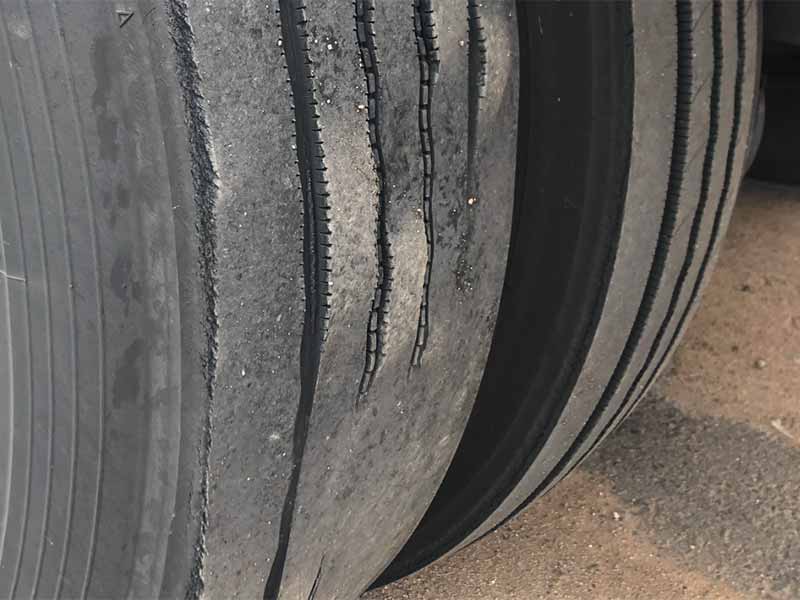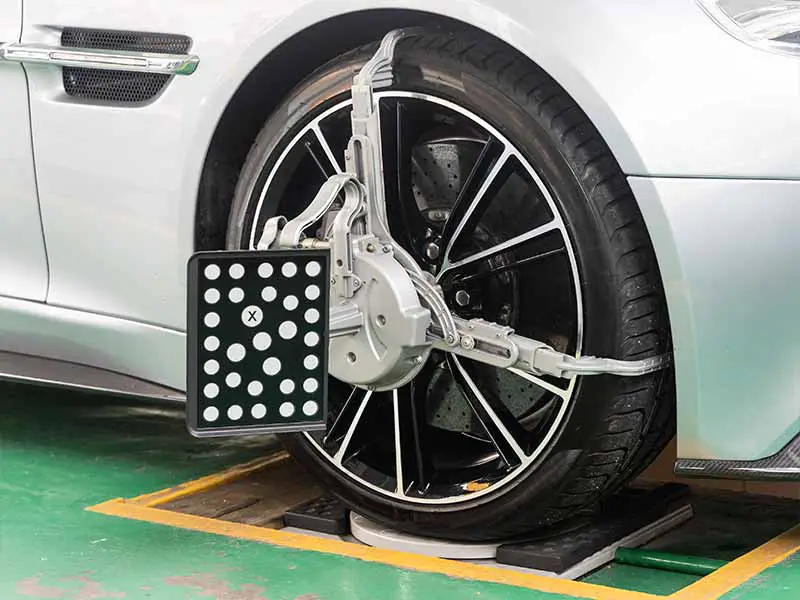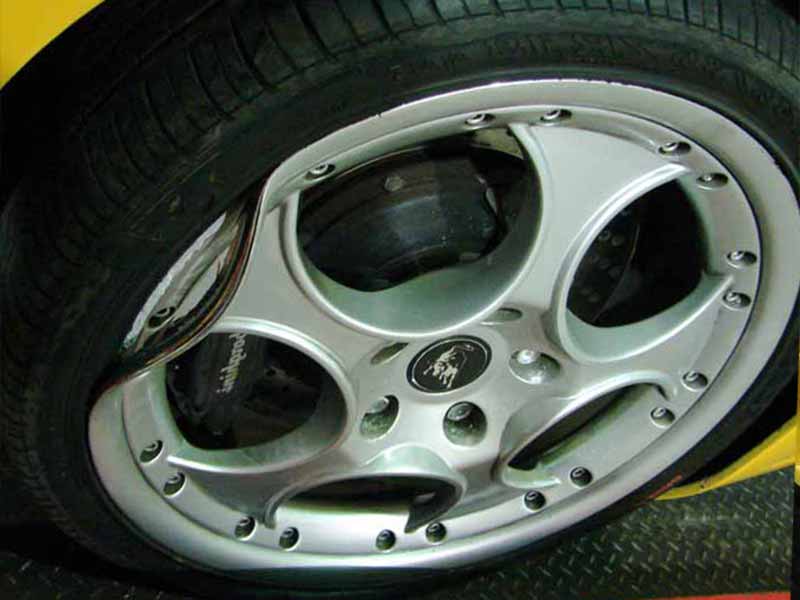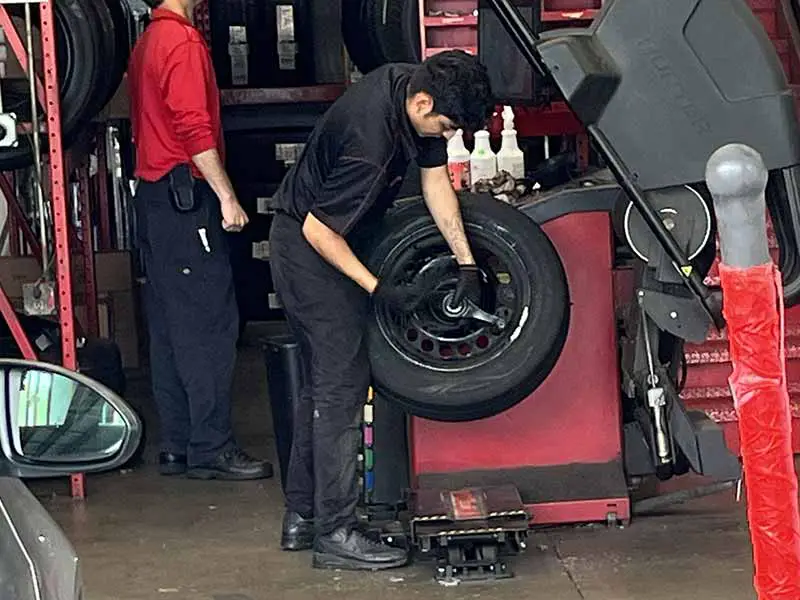Irregular tire wear patterns appears for many different reasons. It could be due to underinflated tires, lack of tire rotations, or even cheap tires that are poorly constructed.
Tire cupping occurs usually from unbalanced tires, but not all tires with signs of cupping are caused by out of balance wheel assemblies. A bent rim or worn suspension components can cause a cupped tire.
Tire Cupping
Tire cupping is an uneven tire wear pattern that appears as diagonal grooves across the tire tread. Cupping is the result of a tire bouncing as it spins.
The wobble is usually caused by tire balance problems but can also be the result of damaged suspension components, a bent wheel, or potentially alignment issues.
Irregular tire wear of any kind shortens the life of your tires and is a safety concern. It’s important to know the signs of tire cupping as well as the causes and fixes.
Let’s take a closer look.
Tire Cupping Symptoms
The main symptoms of cupped tires are:
- Scalloped Tires
- Rhythmic Sound
- Vibration
Tire Scalloping
Tire cupping of the tread pattern is a symptom itself. The scalloped diagonal pattern across either the entire tread or only the inner or outer shoulder of the tire is a visual symptom that you can identify.
In some circumstances, it may be more subtle and difficult to see clearly. This is especially true when the tire scalloping is only on the shoulder and more mild.
Cupped Tire Noise
The rhythmic sound of the tire moving up and down and the different sounds of the tread wear pattern as the tire comes into contact with the road surface should alert you to an issue.
The tire noise is usually easy to hear over the normal road noise, but may be less noticeable if the problem is not severe.
It’s very possible to have mildly cupped tires and not hear any unusual noise at all.
Vibration
Vibration or shaking of the steering wheel is more noticeable with front tires cupping than rear tires. Since the front tires are not only directly connected to the steering wheel, but also much closer to the driver, the vibrations and shaking is more easily felt.
Rear tire cupping is usually very difficult to feel except when it is particularly bad. If you can feel your rear tires shaking you know the problem is serious.

Tire Cupping Causes
Understanding how cupped tires develop will help you identify the cause. Simply buying new tires would be a waste of money if the problem that is causing the tires to wear unevenly isn’t understood and corrected first.
Tire Imbalance
The most common cause of tire cupping is wheels and tires that are out of balance. This most frequently happens when a wheel weight has been lost. Even a poorly balanced tire shouldn’t be so far out of balance that it would cause cupped tires.
When a tire and wheel assembly is not balanced properly, the wheel and tire will wobble as it spins going down the road. As the heavier point around the tire comes into contact with the road it will cause more pressure at that point. As it reaches the top it will pull the tire away from the road slightly and cause less tread wear.
Eventually this pushing and pulling will cause the tire to begin to basically bounce and cause a tire cupping wear pattern to develop around the tires.
Wheel Alignment Issues
Alignment problems are a notorious source of many different types of uneven tire wear. When misaligned tires travel down the road they can drag slightly or even cause a subtle skipping of the vehicle’s tires.
Camber, caster, and toe should all be kept within the manufacturer’s specifications. This includes when making changes to your suspension parts such as lower or raising your car or truck.
Ensuring your car’s suspension system is in correct alignment is important to prevent tire cupping and many other uneven wear patterns.

Worn Shock Absorbers
Shock absorbers are responsible for basically taking the “bounce” out of the springs that your vehicle rides on. Without shocks or struts, your car or truck would continue to bounce for quite a while after every little bump.
Old shocks that are leaking or just worn out will be less able to control the rebound of the springs in your suspension. This will lead to a bouncing of your tires and cause tire cupping to develop over time.
Bent Rims And Runout
Bent wheels or those that are low quality and have excessive vertical or lateral runout can cause tire cupping to occur.
Runout, for those unfamiliar with the term can be described as something that is slightly bent or out of round.
Vertical runout is when a tire or rim isn’t round and wobbles vertically as it spins. Lateral runout is when usually a wheel, but possibly a tire, isn’t perfectly vertical when looking from the front of your car or truck at your vehicle’s tires.
Poor quality tires and wheels can make it difficult to balance tire and wheels, but it should be possible except in the most extreme circumstances.
If damage to wheels and tires occur after wheels and tires have been balanced, broken steel belts in tires or damage to rims can through balance off and cause a wobbling effect while the wheel assembly spins.

How To Fix Cupped Tires
Now that we understand what causes a cupped tire, let’s discuss in detail how to fix the problem.
Road Force Balancing
Occasionally having your wheels and tires rebalanced is one of the best ways to avoid tire cupping. And doing so with a road force balancer will ensure the most accurate tire balancing results.
Road force balancers, as you may have guessed from the name, apply pressure to the tire similar to the weight of your car or truck on your vehicle’s tires. This creates the most real-world simulation when having your wheels and tires balanced.
Once your wheels and tires have been balanced, they won’t stay that way. Over time as your tires lose rubber from normal wear. Your wheels can also get damaged and become slightly out of balance due to curb strikes and potholes.
We recommend rebalancing your wheel assemblies every 10,000 miles to prolong tire life and help reduce uneven wear such as tire cupping.
Inspect Suspension Components
Your vehicle’s suspension is critical to even tire wear and your safety. Some suspension parts will wear out and others will become bent from speed bumps, potholes, and curb strikes.
Worn suspension parts can cause tire cupping and other types of premature tire wear. If your suspension components have worn bushings and ball joints or have become damaged or bent, the suspension can’t properly do it’s job.
Regularly inspecting your vehicle’s suspension for problems is part of regular tire maintenance. Worn or damaged suspension components make it difficult for your tires to properly align and are a very common reason for irregular tire wear.
Repair Or Replace Damaged Wheels
Bent rims can easily cause a wobble in the wheel assembly. Tire cupping starts when there is a problem that causes the tire to bounce or wobble.
Wheels are usually very expensive unless you have steel wheels. If you have inexpensive steel wheels with hub caps you should definitely have your wheels replaced as soon as possible.
For those with expensive wheels, you may be able to have them repaired. Your local tire shop may be able to perform this service for you or they can outsource it or direct you to a local wheel repair shop.
Wheel repairs aren’t always possible and it’s worth mentioning that the metal that was bent will more easily bend in that spot again. Often it’s worth having a wheel fixed instead of replaced for the overall savings.
Perform Regular Tire Rotations
Uneven wear of your tire tread occurs differently at each wheel position around your car or truck. By rotating your tires every 5,000 miles you more evenly distribute the unique wear patterns more evenly across the average of all four tires.
Most vehicle and tire manufacturer’s will have recommended tire rotation intervals. These are often every 5,000 miles or more. We recommend ensuring you rotate tires at least as often as is necessary to maintain your tire manufacturer’s tire warranty.
Tire rotation is usually the main factor considered when determining if a tire warranty should be honored. If you haven’t met this simple criteria you can easily have your claim denied which can end up being a significant amount of money.
Do Cupped Tires Need To Be Replaced?
A cupped tire can not be fixed, but a tire with mild tire cupping may not need to be replaced.
Once the root cause of the problem has been solved you can continue to ride on the cupped tires until normal tire wear causes the tire’s tread to even back out and wear evenly again.
More severely cupped tires may need to be replaced. Extremely cupped tires can not properly grip the road surface and would be unsafe to continue to use.
Is Tire Cupping Dangerous?
Tire cupping can be quite dangerous in the more extreme circumstances. This is especially true when the root cause has not been fixed. As the tire spins, it can literally lose contact with the pavement if the problem is severe.
Fixing the source of the cupping problem should be priority one. Having the tire tread inspected and determining if the tires need to be replaced should be the next important step.
If any area of your tire’s tread has a tread depth of 2/32″ or less, they should no longer be used because you run the risk of hydroplaning.
Resources
Below are some links you may find helpful when learning about tires
Final Thoughts
The best defense against irregular tire wear in general is proper tire maintenance. Check tire inflation pressures regularly, rotate your tires every 5,000 miles, and have your wheels and tires rebalanced and aligned every 10,000 miles.
Stay on top of these tire maintenance practices and you’ll minimize irregular tire wear before it can become a serious problem. You’ll also get alerted to problems as soon as the wear appears.
Good luck and happy motoring.






